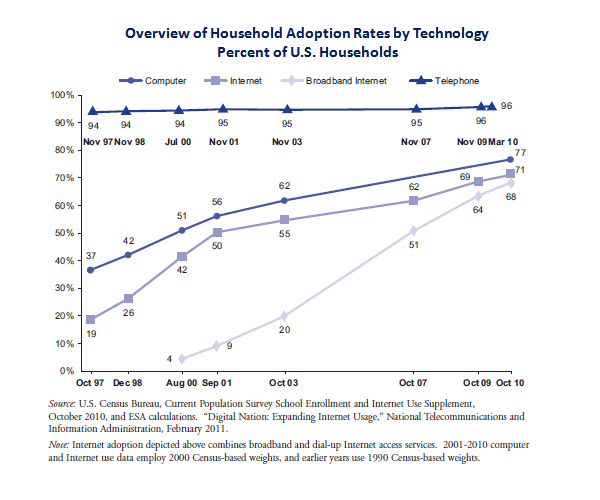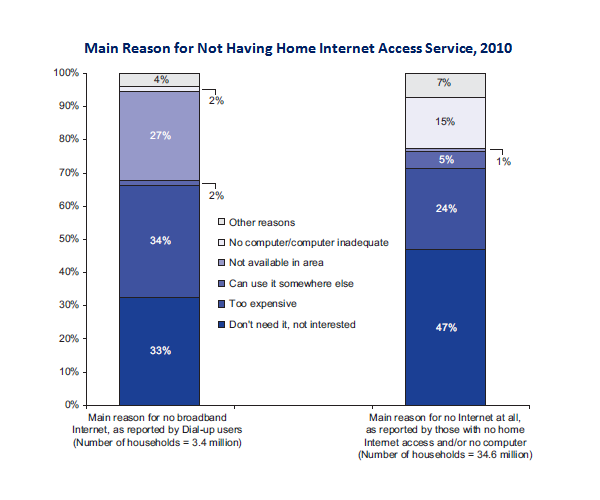Statistics: New Government Report Looks at Broadband Adoption in U.S. and Shows Digital Divide Persists
Update (November 15): European Commission claims 95 per cent of citizens have broadband access (via V3.co.uk)
Now, to U.S. broadband statistics:
From the NTIA Blog:
The Economics and Statistics Administration (ESA) and the National Telecommunications and Information Administration (NTIA) released a report today entitled Exploring the Digital Nation: Computer and Internet Use at Home (PDF). This report investigates broadband Internet use in the United States and finds that disparities continue to exist in broadband Internet adoption among demographic and geographic groups. The report also delves into the reasons why households have not adopted broadband Internet.
Broadband internet adoption has increased substantially in only a few years, rising to 68% of households in 2010 from only 51% of households three years earlier and from 64% in 2009, the last time ESA and NTIA looked at these issues.
While this points to progress, a digital divide still exists between different racial and ethnic groups and between urban and rural areas in the United States. Broadband adoption rates varied substantially between different racial and ethnic groups, with 81% of Asian and 72% of White households having broadband Internet access, compared to only 55% and 57% of Black and Hispanic households. The urban-rural divide is also wide, with 70% of urban households having broadband Internet access compared to only 57% of rural households. Socio-economic differences, such as income and education, explain much – but not all – of this divide.
Here is what we know: Households that do not subscribe to any Internet service—dial-up or broadband —cited as the main reasons a lack of need or interest (47%); lack of affordability (24%); and an inadequate computer (15%). However, 27% of dial-up users — a rapidly declining group of users — indicated that they did not have broadband internet access service in their area.
Access the Full Text Report (72 Pages; PDF)
Overall
- Sixty-eight percent of American households used broadband Internet in 2010, up from 64 percent in 2009. Only three percent of households relied on dial-up access to the Internet in 2010, down from five percent in 2009. Another nine percent of households had people who accessed the Internet only outside of the home.
- All told, approximately 80 percent of American households had at least one Internet user, whether inside or outside the home and regardless of technology type used to access the Internet.
- Cable modems and DSL were the leading broadband technologies for home Internet adoption, with 32 percent and 23 percent of households, respectively, using these services.
Differences in Household Broadband Adoption
- Households with lower incomes and less education, as well as Blacks, Hispanics, people with disabilities, and rural residents, were less likely to have Internet service at home.
- Eighty-one percent of Asian households and 72 percent of White households had broadband at home, compared to 57 percent of Hispanic households and 55 percent of Black households.
- Seventy percent of urban households had broadband at home, compared to 57 percent of rural households.
- Households with school-age children were more likely to have broadband at home (78 percent) than the national rate. Older householders, particularly those ages 65 and older (45 percent), were less likely to have broadband at home.
- Less than half (43 percent) of households with annual incomes below $25,000 had broadband access at home, while 93 percent of households with incomes exceeding $100,000 had broadband.
- Average broadband adoption in 2010 varied by state from about half (52 percent) of all households to 80 percent.
Role of Socio-Economic Factors
- Socio-economic differences do not explain the entire broadband adoption gap. For example, after accounting for socio-economic and geographic factors, Black and Hispanic households still lag White households in broadband adoption by 11 percentage points, though the gap between Asian and White households disappears.
- After accounting for socio-economic and demographic factors, rural households still lag urban households in broadband adoption by five percentage points.
- In contrast, differences in socio-economic characteristics do explain a substantial portion but not all of the broadband adoption lag among people with disabilities.
Reasons for Not Subscribing to Broadband at Home
- The main reasons cited for not having Internet access at home were a lack of interest or need (47 percent), the expense (24 percent), and the lack of an adequate computer (15 percent).
- Not surprisingly, individuals without broadband service at home relied on locations such as public libraries (20 percent) or other people’s houses (12 percent) to go online.
Long-term Trends in Internet and Computer Use
- Between 2001 and 2010, broadband Internet use at home, regardless of technology type, rose from 9 percent to 68 percent of households.
- Between 1997 and 2010, Internet use among households, regardless of technology type, rose from 19 percent to 71 percent.
- More than three quarters (77 percent) of American households had a computer at home in 2010, up from 62 percent in 2003.
Access the Full Text Report (72 Pages; PDF)
Filed under: Libraries, News, Patrons and Users, Public Libraries
About Gary Price
Gary Price (gprice@gmail.com) is a librarian, writer, consultant, and frequent conference speaker based in the Washington D.C. metro area. He earned his MLIS degree from Wayne State University in Detroit. Price has won several awards including the SLA Innovations in Technology Award and Alumnus of the Year from the Wayne St. University Library and Information Science Program. From 2006-2009 he was Director of Online Information Services at Ask.com.




